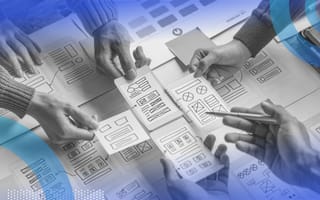Incorporating continuous design into your innovation approach can feel like demo day from a home renovation.
What Is Continuous Design?
Continuous design is the method of integrating the typical user experience iteration workflow directly and in sync with the overall agile development process — adding another loop of experimentation and assurance of building the right thing and building the thing right.
Instead of a hard hat and a hammer, breaking down the walls of a siloed process requires merging the disciplines of design, development and user feedback into a single workflow. While adopting the cross-collaboration and departmental dependency can be difficult, success creates an environment where each team member contributes, user feedback is valued, time is better spent and money is saved. Happy teams. Happy users.
Continuous design doesn’t follow a linear structure. Design, development and strategy happen simultaneously driven by a customer feedback loop with ongoing iterations. Guiding this nonlinear process requires the following six must-haves that product and engineering leaders should incorporate to ensure their continuous design process generates the required results.
Openly Collect Ideas
Continuous design requires the ongoing collection of feedback on what’s working and what isn’t — including from internal team members, external team members and perhaps most critically, users. As feedback is incorporated over the short term, new market opportunities, changes in product value as well as the introduction of long-term business goals will naturally cause these ideas to evolve. Insights should be stored somewhere that is transparent, easily accessible and regularly curated and evaluated by the team.
Invest in Concepting
Determining whether ideas are worth further pursuit requires plenty of “back of the envelope” type visualizations. Concepting helps to get everyone on the same page and makes sure all share the same rough endpoint. Think of this as an early-stage investment versus spending heaps of time and money on full-blown design explorations.
Test Regularly
Here’s where the innovation adage “learn fast and break things” happens. With a visual representation of a concept in hand, seek feedback from the standpoint of whether this concept solves a user’s problem. Collecting this feedback using concepts ensures users focus on the goal outcomes and potential approach rather than being distracted by the design.
After reviewing the feedback, teams may decide to change the concept with additional tweaks, abandon the concept altogether or double down if the feedback validates your direction. For ideas that spark a significant amount of change, test multiple times before giving the green light. You’ll almost always find something to improve or better yet, remove.
Use No-Code and Low-Code Trials
Developing a functional prototype with the understanding that the product will evolve with the process is another opportunity to break down departmental silos. A trial can ensure everyone goes through the same process of gathering customer information to move development forward.
A note of caution: If the organization doesn’t understand how continuous design works, the trial stage is where the process will typically stall. Less costly no- and low-code techniques will give future delivery efforts a head start by removing the throw-away work concerns many organizations have when they begin experimenting with continuous design. No- and low-code trials also bring engineers more easily into the process, which will improve execution down the development line.
Validate Your Approach
The validation stage is where the prototype is tested for value and ease of use. Instead of a basic visual concept, users are now validating a product’s first functional state. Feedback here should focus on ease of use, goal accomplishment, and initial quality. We recommend testing prototypes with about five potential or current users. This article by Jakob Nielsen of Nielsen Norman Group explains why five is ideal.
Learn While Building and Releasing
Remember, a release doesn’t signal the end of the continuous design process. It’s an opportunity to get quantitative data during the development process and early customer trials to get the most ROI. Taking a functional prototype to full development gives insight for a successful launch. Throughout the building and release stage, improvements are driven back into the product roadmap as discoveries from feedback in the marketplace convert to immediate successes.
This includes qualitative data in the form of user feedback, and quantitative data in the form of performance analytics. This is not to imply that the product will be constantly changing, especially not the outward-facing parts, but there’s room for subtle interface or behind-the-scenes enhancements that are invisible to the user but make a profound impact.
The appeal of continuous design is that the process allows teams to innovate quickly and figure it out as they go. The result is a more agile approach to delivery. The principles of continuous design — building knowledge through feedback and testing, connecting with end users and staying current in the market — when implemented correctly, can break down departmental silos, save time and money and also provide a distinct competitive advantage.





